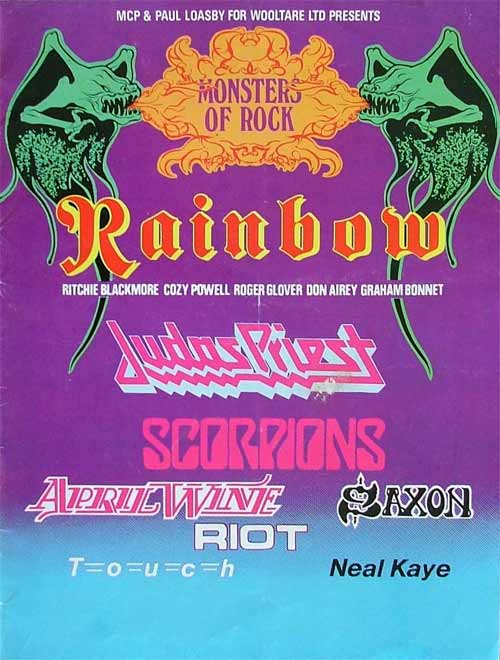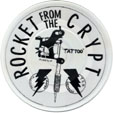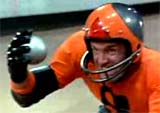:format(jpeg):mode_rgb():quality(90)/discogs-images/R-6506832-1455614268-9024.jpeg.jpg)
Rocka Rolla 1974
Much like Yes, Genesis, ZZ Top, or even Caravan to an extent, Priest's debut is a bit tentative. It SOUNDS like JP, but at the same time it doesn't. The songs aren't really there in other words. I like quite a bit here to be honest, but things would improve considerably with the next LP. There's nothing really fast on this record for one thing, and Rob's trademark high-pitched scream is barely present. I guess I should talk about the development of heavy metal in the '70s briefly. Like we say that King Crimson really birthed prog in '69, Black Sabbath did the same with metal. Sure, there's many antecedents before that, but it's mostly blues rock or heavy psychedelia. There's a world of difference between what the Jimi Hendrix Experience or Cream were doing (or even Led Zeppelin) in the late '60s and what Sabbath did on that first album. Real metal doesn't rely on blues scales so much (Fripp didn't want to work with musicians who played blues either), and has nothing to do with psych. Now I have no problem with blues or blues rock myself, just relating what has been written by metal writers like Martin Popoff and many others. Anyway, enough with the history lesson. I see Judas Priest as the next major development in the metal timeline after Black Sabbath.
Rob Halford – vocals, harmonica
K. K. Downing – guitars
Glenn Tipton – guitars, synthesizers
Ian Hill – bass
John Hinch – drums
1. "One for the Road" (Rob Halford, K. K. Downing) 4:34
Yeah, I'm digging that slow, sensual rhythm here. It picks up and becomes a proper rocker soon enough. Another element of real metal is that there's a dark vibe, and it has to be heavy. Both elements are in effect here, but it's only 1974 and the genre is barely past its infancy. A tune to celebrate music and touring is a fine way to start things off for our soon-to-be leather boys.
Wiki - "Rocka Rolla is the debut studio album by English heavy metal band Judas Priest, released on 6 September 1974 by Gull Records. It was produced by Rodger Bain, who had made a name for himself as the producer of Black Sabbath's first three albums. It is the only album to feature drummer John Hinch. According to the band, the album was entirely played live, in studio (i.e. all musicians playing simultaneously as in a concert, vs. the more popular method of each musician's parts being recorded separately and then mixing them).
According to the band there were technical problems in the studio, resulting in poor sound quality and a hiss through the album. Guitarist Glenn Tipton had just joined when recording of Rocka Rolla began and did not contribute any songwriting except on the title track and "Run of the Mill". He did come up with the songs "Tyrant", "Epitaph", and "Ripper", but Bain considered them not commercial enough and rejected them. Bain also rejected the concert staple "Whiskey Woman" which later, with contributions from Tipton, morphed into "Victim of Changes". These songs were eventually all included on their next album, Sad Wings of Destiny."
Damn, can you imagine rejecting those songs? LOL.
2. "Rocka Rolla" (Rob Halford, K.K. Downing, Glenn Tipton) 3:05
Another good 'un where Rob extols the virtues of a hard-living woman not unlike the one he'd present us with in "Victim of Changes" later. Catchy, short, could have been a hit.
"At this point of the band's career, they had not yet developed their signature look of leather and studs. They had appeared on a British television programme called The Old Grey Whistle Test in 1975, performing "Rocka Rolla" and "Dreamer Deceiver", and their wardrobe was very "hippified" as journalist Malcolm Dome put it. This footage was included on the Electric Eye DVD. In addition, the album is more blues/hard rock oriented than their later releases, and also has some slight progressive rock influences that would continue through to Stained Class, but to a lesser extent, and would be abandoned in later releases. This makes the album's style virtually unrecognizable when compared with later Priest albums, although "Rocka Rolla" does feature dual guitars and "Run of the Mill" is the first song that was explicitly designed for Halford's, rather than Atkins', vocal range. The original UK LP has a longer version of "Rocka Rolla" than the version used for the US LP release, and most CD releases. It has an extra verse and chorus at the beginning of the song." - Wikipedia
3. "Winter" (Al Atkins, K.K. Downing, Ian Hill) 1:41
Slow, effects-laden (in the beginning) piece which sounds like the guys experimenting in the studio more than anything else. It does get loud though and it seems to concern itself with a young man already feeling old, like he is tired and has no place to go. This and the next two tracks all form a suite. Wikipedia: "Drummer John Hinch was dismissed in 1975 before the next record was recorded. Tipton would later refer to him as being "musically inadequate" for the band's future plans." Ouch!
4. "Deep Freeze" (K.K. Downing) 1:21
A continuation of the same themes really. The narrator feels the chill of Winter coming on both literally and metaphorically. Wikipedia - "The album was reissued several times over the years and in 1984 it was reissued with a different cover. The original "bottle cap" album cover art was initially intended by designer John Pasche for use with an unspecified Rolling Stones album. The band had filed a lawsuit with the Coca-Cola company."
5. "Winter Retreat" (Rob Halford, K.K. Downing) 3:28
Suddenly, all is right with the world as the sun shines and our hero feels all better. A lot of feedback in the beginning almost reminds me of Hendrix. Some of the gentlest passages on the record are here.
6. "Cheater" (Rob Halford, K.K. Downing) 2:59
The last cut on side one is a rocker (with harmonica no less!) with a decidedly bluesy feel which is okay by me. The singer has found his woman in bed with another man and off to the dresser to get his gun he goes. Not exactly an English thing really, but then Rob wouldn't find his 'woman' in bed with a man either, would he?
Wiki - "The very rare first printing of the UK LP has the words "Thanks for the words Al!" printed last in the credits in the blue circle on the back cover. This, presumably a reference to original singer Al Atkins, has been removed on other versions of the Gull vinyl.
:format(jpeg):mode_rgb():quality(90)/discogs-images/R-6506832-1455614268-3723.jpeg.jpg)
7. "Never Satisfied" (Al Atkins, K.K. Downing) 4:50
We're never satisfied, you see, and life is strange and I'm gonna reach for a gun (again), etc. The second side opens with another pretty good riff rocker. This one kinda sounds like what Priest would become. I like it. Rob does scream on this track - a harbinger of things to come!
"Most of the songs from Rocka Rolla have not been performed by Judas Priest live since the mid-late 1970s, although Halford's solo band performed "Never Satisfied" during live shows in 2003, and the same song was part of the setlist of the Epitaph World Tour. "Rocka Rolla" was performed for the first time since 1976 at Bloodstock Open Air in 2021." - Wikipedia
8. "Run of the Mill" (Rob Halford, K.K. Downing, Glenn Tipton) 8:34
Easily the longest track on the record starts of slowly and deals with another narrator consumed by life's despondency. Depression really seems to be a theme with these guys and I guess their multitude of fans relate in some way. Halford can sing in different registers and most of them are effective. Tell me that this one isn't bluesy though... There's an elongated guitar solo which I quite like as well. But then I would, right? Rob is screaming again too!
Wiki - "Run of the Mill" is a ballad by English rock band Judas Priest from their debut album Rocka Rolla. The song was the first written by guitarist K. K. Downing, soon after vocalist Rob Halford joined the band. Downing wrote it, in part, to display Halford's unique vocal range.
The track was first recorded as a demo circa 1973, along with another early Priest song, "Whiskey Woman". This track would later surface in altered form on Priest's second album as "Victim of Changes". Priest's manager at the time, Dave Corke, brought the demo to Gull Records, who would later sign Priest after their president, David Howells, attended a performance of the band, with Budgie at London's Marquee Club on 11 February 1974. The song was later recorded properly for their debut, Rocka Rolla, in the summer of 1974.
The song's lyrics are about a poor old man, whose "prospects" for a good life "vanished", now embattled and confused by today's society. Following the first two verses is a long guitar jam with Glenn Tipton and Downing. At the end of the song, the music gets heavier as Halford shows off his vocal range by wailing the end lines.
"Run of the Mill" was Priest's longest recorded track until "Cathedral Spires", a track from their 1997 album, Jugulator. It was also the longest track co-written by Rob Halford, Glenn Tipton, and K. K. Downing prior to "Lochness", a track from their 2005 album, Angel of Retribution.
Although Priest has not performed the song since the mid-1970s, many fans and critics consider it to be one of the highlights of the album and a classic early Priest track."
9. "Dying to Meet You/Hero, Hero" (Rob Halford, K.K. Downing) 6:23
An attack on soldiers who kill for king and country, or patriotism, or simply because they're told to, I assume. Don't care for Rob's baritone in this song either. But we're almost at the end and enough good music has already been heard so this cut doesn't bother me. Right before the four-minute mark the time signature changes (yes, there are little prog elements in some of these songs), and it sounds like a whole different thing. I like this second part better actually.
10. "Caviar and Meths" (Instrumental) (Al Atkins, K.K. Downing, Ian Hill) 2:02
A slow fade in to a snippet of a longer song (you can hear the whole thing on youtube, it's not the fourteen-minute Atkins version, but a seven-minute Priest tune).
"Several of the songs on the album feature contributions from the band's previous frontman Al Atkins and had been regular parts of their live performances in Manchester, where the band had achieved a cult following during the previous few years. The track "Caviar and Meths" was originally a 14-minute effort penned by Atkins, Downing, and Hill but due to time constraints, only the intro was recorded for the album. A longer version of the song appears on Atkins's 1998 album Victim of Changes. Though not the full-length version, it is notably longer at seven minutes. That album also contains covers of "Winter" and "Never Satisfied". - Wikipedia
:format(jpeg):mode_rgb():quality(90)/discogs-images/R-2971636-1309804077.jpeg.jpg)
:format(jpeg):mode_rgb():quality(90)/discogs-images/R-2971636-1309804084.jpeg.jpg)


:format(jpeg):mode_rgb():quality(90)/discogs-images/R-2085738-1591028302-3805.jpeg.jpg)
:format(jpeg):mode_rgb():quality(90)/discogs-images/R-2085738-1591028310-2547.jpeg.jpg)

:format(jpeg):mode_rgb():quality(90)/discogs-images/R-1956497-1380228284-4615.jpeg.jpg)
:format(jpeg):mode_rgb():quality(90)/discogs-images/R-1956497-1380229614-2389.jpeg.jpg)
:format(jpeg):mode_rgb():quality(90)/discogs-images/R-1956497-1380229003-5734.jpeg.jpg)
:format(jpeg):mode_rgb():quality(90)/discogs-images/R-1956497-1380228306-8844.jpeg.jpg)
:format(jpeg):mode_rgb():quality(90)/discogs-images/R-2130201-1423590327-2884.jpeg.jpg)
:format(jpeg):mode_rgb():quality(90)/discogs-images/R-19267681-1624605127-7076.jpeg.jpg)
:format(jpeg):mode_rgb():quality(90)/discogs-images/R-15376911-1590535011-5404.jpeg.jpg)
:format(jpeg):mode_rgb():quality(90)/discogs-images/R-3280250-1600111629-3042.jpeg.jpg)